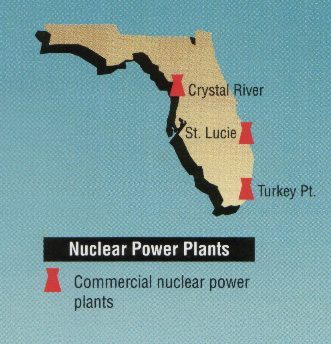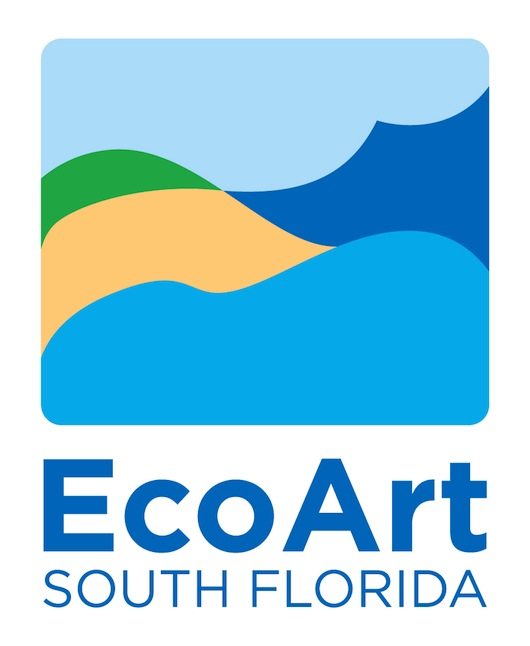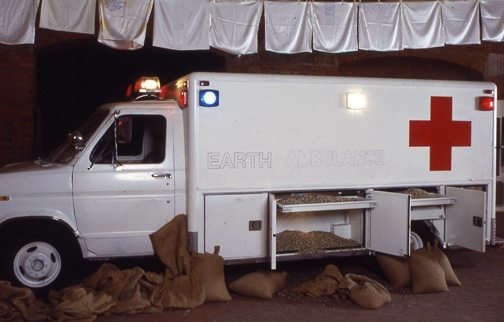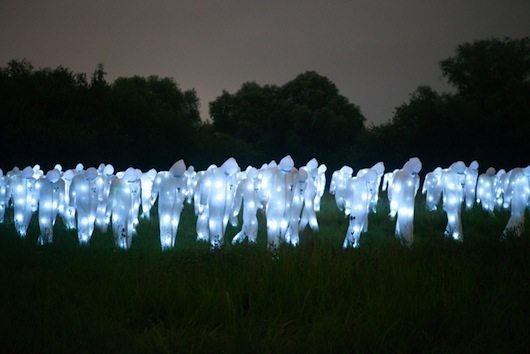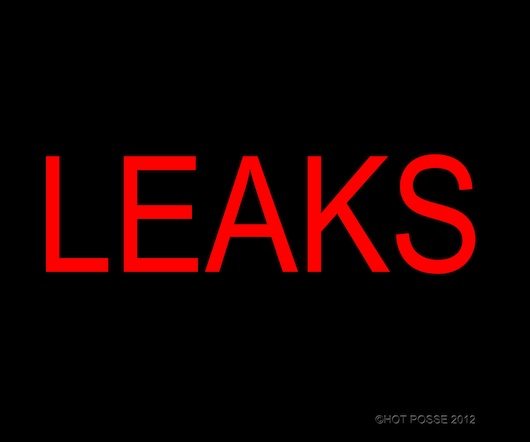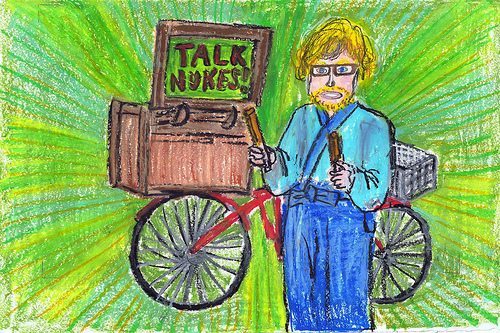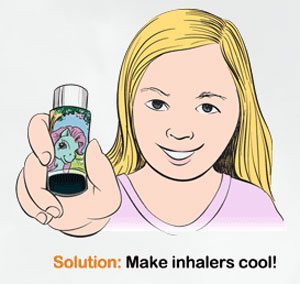Location: South Florida, USA
I. MINDSHIFT POST-FUKUSHIMA
THE FUKUSHIMA NUCLEAR DISASTER HAS caused me some mindshifts. Especially about what works and what doesn’t when attempts are made to engage art with activism. And if (or when) encouraging activism through art, to shut down nuclear power plants in favor of cleaner, safer alternatives, can be seen as a form of EcoArt. My conclusion? Much depends on context, timing and choice of aesthetic strategies.
As I began to write this essay in January, 2012, 10 months after Fukushima, I was immersed in learning about the ongoing Fukushima nuclear crisis, and our own nuclear energy situation here in Florida. But I was far from being informed enough. This lack of information and understanding of the implications of Fukushima for us here in Florida was not only a problem I experienced. Most of my friends and colleagues working on environmental issues were at about the same level as I.
By January, 2012:
I had learned that one of the Fukushima reactors was in a permanent open fission condition (it still is), pouring radiation into the ocean and air; and that even here in Florida, EPA was registering radiation spikes traced to Fukushima.
I found out that the 35 year old Crystal River nuclear plant, one of three in Florida, had been shut down since 2009 when cracks were discovered in the containment buildings (the last shield against deadly radiation escaping into the atmosphere during an accident); and that reopening it was being considered.
I was shocked to learn that, over the years, repeated attempts had been made by the power company to “repair” the Crystal River structure–this, despite evidence that attempts to “repair” the building to date have only caused more serious cracks to occur, some of them 4-5 feet wide and 25 feet in length.
And, I knew that, on November 9, 2011, regulators in Florida gave two utilities permission to begin charging customers up front for nuclear plant expansion that won’t be completed for at least a decade, if at all. Currently, Florida-based advocacy efforts by (non-art) anti-nuke organizations are focused around what amounts to a corporation’s taxation of consumers for building new nuclear reactors for existing plants. A smaller effort is focusing on permanent shutdown of the Crystal River plant. These activists use the basic tools of lawsuits, lobbying and community education presentations on the health threats of nuclear power plants. Art has been absent.
In light of all this, I wonder what it would take for Florida citizens to become deeply aware of the nuclear threat from both Fukushima and the US’s own 104 aging nuclear power plants? Also, how could EcoArt, an activist art practice emphasizing direct intervention against environmental degradation, address the threat of radiation “spills” and “accidents” from Florida’s aging nukes?
II. ECOART: SOCIAL SCULPTURE + “SLOW ACTIVISM”
FIVE YEARS AGO, IN 2007, I FOUNDED EcoArt South Florida, (www.ecoartsofla.org) inspired by artists who are part of the evolving EcoArt Movement. (http://www.ecoartnetwork.org/). EcoArtists work in cross-disciplinary art, science and community engagement collaborations to directly affect a particular ecological problem. Amelioration is the goal. What emerges in this practice are “social sculptures” which emphasize intervention to halt or slow (a) process(es) damaging an ecosystem and activate those that make an ecosystem healthy. Deployment of ‘social sculpture’ can be an onerous undertaking, requiring extensive long-term effort and skillful coordination of entities/professionals/private citizens not accustomed to working together. Any successful EcoArt project requires of its instigator(s)–and collaborators– patience, willingness to experiment, and a highly developed intuition on when to shift direction and reconfigure alliances. These are not skills normally taught in studio art programs.
Clearly, EcoArt practice is not for every artist and there are very few practicing EcoArtists living in Florida. This is why I founded EcoArt South Florida, a nonprofit that seeks to catalyze the development of South Florida as a major center for EcoArt practice. EASF selects local artists to paticipate in a rigorous apprenticeship with a master EcoArtist where they learn how to apply their skills and imagination to specific ecological problems in a “social sculpture” approach. I have also consciously conceived of EcoArt South Florida itself as a social sculpture initiative which operates in a manner theorist Wallace Heim has called “slow activism.” For elucidation of both “social sculpture” and “slow activism” see http://ecoartsofla.org/resourceslinks/.
III. ANTI-NUKE ECOART: DIRECT OR INDIRECT INTERVENTION?
HERE IS THE DILEMMA, HOWEVER: in applying direct intervention EcoArt approaches to most ecological problems, an EcoArtist and the communities s/he seeks to activate will not have their health negatively affected, or their very existence threatened. But, could we say the same about directly addressing nuclear power plant issues?
The plants are more dangerous than they seem, or than we are being told they are. Scientific reports are increasingly available that indicate the US’s 104 aging nuclear power plants are not only accidents waiting to happen; they silently and invisibly inject various amounts of radiation into air and water supply more or less continuously, even when no obvious major faults have occurred. Therefore, the potential for negative impact on artists and their collaborators in any direct or long term intervention related to nuclear power plants could be very high.
The extreme crisis represented by the ongoing nuclear emergency at Fukushima, and the dearth of public awareness of the potential dangers of Florida’s aging nuclear power plants spurred me to find out if any Florida artists were addressing, directly or indirectly, the dangers of local nuclear issues. In late Fall 2011, I began to contact artists, environmental activists and nonprofit groups, both inside Florida and elsewhere, hoping to get a snapshot of how activism around nuclear power plants had been affected by the Fukushima events, and examples of how artists had engaged with these activist efforts.
I found that there are about as many artists engaged with nuclear power plant issues in Florida as with ecological damage in general, which is to say, not many. To my knowledge, as of May 2012, there have been only two quasi-art-related efforts to raise awareness about the dangers of Florida’s nuclear power plants in the aftermath of the Fukushima events. Both were group performances and neither directly engaged a nuclear plant. The first was a mock evacuation performed in kayaks near the Turkey Point plant south of Miami. The other was a “die in,” marking the March 11th anniversary of the Fukushima disaster, orchestrated by activists in front of the Energy headquarters (owners of the damaged Crystal River plant) in Tampa.
While these were valiant efforts, they were isolated, attracted little media attention and therefore had little education effect on the plants’ dangers. They also did not directly affect the dangers of the plants. Other approaches deployed outside Florida show the way.
IV. MODELS: CALL THEM ECOART?
HERE ARE SEVERAL PROJECTS (some dating back to the 1980s) I believe can serve as models for a kind of quasi-direct mostly indirect EcoArt tactic. I enumerate them here to suggest how artists (in Florida and elsewhere) might build on their example, to engage, outside the traditional art gallery (and market) system, in synchrony with nuclear power plant activism including lobbying, law suits, traditional “teach ins” and “mass” mobilizations.
Earth Ambulance was first created in 1982 by feminist anti-nuclear activist artist Heléne Aylon—the Featured Artist in this issue of WEAD Magazine. This activist kinetic performance art was inspired by Dr. Helen Caldicott’s 1980s plea, to anyone listening, for immediate and total nuclear disarmament.
The original 1982 “ambulance” was a truck painted to resemble an ambulance. A key element of the mobile performance are hundreds of common pillowcases carried by the Earth Ambulance, donated by participants, representing the “nightmares” people experience about the potential for nuclear obliteration of life on earth. Some pillow cases have been inscribed with messages, others filled with earth dug close to missile launch sites and from Native American reservations frequently used either as nuclear test sites, or for uranium mining and processing. Still others are blank, representing the unknown future.
In the 1992 exhibition under the Brooklyn Bridge, a selection of these pillowcases were strung from the bridge girders above the parked “ambulance.”
The ambulance also has been a focal point for mass demonstrations.
The current updated version of Earth Ambulance is “parked” at the Hudson Valley Center for Contemporary Art in Peekskill, NY—waiting for deployment—to Florida, perhaps?
Sisters of Survival (S.O.S.): Nancy Angelo, Jerri Allyn, Anne Gauldin, Cheri Gaulke and Sue Maberry
A collaborative performance art group founded in California in 1981 which initiated “End of the Rainbow,” a three-part project including a European tour in Spring 1983. S.O.S. also produced a media performance (“Shovel Defense”), an artists’ book (“Sisters Of Survival’s Memento Mori”), a billboard (“Something is Clouding Your Future”), and other theatrical and participatory performances.

“S.O.S” The name both of the feminist performance group, and the semafore flag signal they used in many of their anti-nuclear demonstrations in the 1980s. (Photo: Anne Gauldin)
The group formed in reaction to a Time Magazine cover story about a huge anti-nuclear demonstration in Europe in reaction to the Reagan Administration’s decision to deploy Anti Ballistic Missiles in Europe. They chose the iconic image of the habited nun (albeit the habits were created in rainbow colors!), the stereotypical strict teacher harboring no tolerance of resistance to education..
A catalogue (Sisters of Survival) was produced by the Otis College of Art and Design in Los Angeles in conjunction with Otis’ retrospective documentary exhibition about the feminist art movement of the 1970s in California – Doin’ it in Public: Feminism and Art at the Woman’s Building
Florida could use the ministrations of the Sisters! Reconstitute yourselves for us down here in Florida, please!
“RadioActive Control” (Luz Interruptus) is an outdoor installation consisting of rows of 100 inflated standing HazMat suits, emblazoned with the nuclear symbol, and lighted from within.
Luz Interruptus is a Spanish art collective that performs light installations in urban settings that literally “shine light” on problematic or misused urban spaces. About this installation, Luz Interruptus says: “We are by no means experts on nuclear issues, but we are opposed to nuclear power plants for all the reasons brought forward by the Fukushima disaster. While we undoubtedly will do other installations related to this theme, it is not the main focus of our work.”
“The installation ‘Radioactive Control’ was created for the Dockville Festival in Hamburg, Germany and sought to demonstrate, in a humorous tone, the paranoia that we are suffering from since the escape of radioactive material in Japan has brought into question the safety systems at nuclear power plants.”
“Germany has been the first developed country to announce the total abandonment of nuclear energy by 2022. We know that this was not an altruistic decision and has a lot to do with the creation of new and innovative industries, which will make them pioneers in the market. But, just in case they change their minds, we already know that what politicians legislate today, they change tomorrow with impunity, we wanted to simulate, for the festival, a life under the constant threat of nuclear accidents.”
Luz Interruptus has indicated their enthusiasm to travel to Florida with this work and has provided a budget to do so. http://www.dezeen.com/2011/08/30/radioactive-control-by-luzinterruptus/
Hot Posse Series 104/Hot Posse Hot Flash (Hot Posse)
This new collaboration between two California artists began just five days after the Fukushima disaster. The collaborators bring to the project long activism involvement: in one case organic urban farming, film and installation art, and in the other environmental/conceptual art, performance art and videography.
The two-pronged project aims first (in HOT POSSE SERIES 104: http://www.youtube.com/watch?v=lkADC9MROlk) to inform the public about the dangers of geography (location near fault lines and water sources, in particular) and of malfunction and human error that make the US’s 104 nuclear power plants accidents waiting to happen, accidents that have profound negative implications for water, air and food safety. The media of choice are aggressive word art and graphics combined with cinematic music. The venue: social media such as Facebook, Twitter and Youtube.
“We are seeking an audience among the younger generation,” said one Hot Posse partner. “The younger people are the ones who will feel the effects of our action or inaction now. If San Onofre or Diablo Canyon should go, we have to know that East-bound winds will carry the radiation into the agricultural valleys of California. This is the food basket not just for California but for the US as a whole, and beyond.”
The second focus they are calling “Hot Posse Hot Flash” is on “news flashes” that release information the general public needs to know about nuclear plants that is suppressed or not considered newsworthy by mainstream print and electronic media. Another aspect of the “HOT FLASH” focus identifies and underscores particularly egregious lapses, honored with “The Brass Balls Award” (this “award” is repurposed from the original 1991 art project by The Sprockets).
While HOT POSSE’s emphasis will be on the social media that has so captivated the younger generation, they also intend to do projections of these short video works…on exterior blank walls in key locations, and in video installations inside traditional art venues.
We want them on walls (dare we hope for a projection onto a nuclear plant containment building?) right here in Florida!
Talk Nukes! (Doug Beacom)
Doug and his family recently moved from San Diego, Doug’s home town, where they lived within 50 miles from the crippled San Onofre nuclear power plant. They now live on a farm near Santa Cruz in Northern California. From 2004-2006 Doug worked for the Japanese Ministry of Education in Nagasaki. His wife is a native Tokyoite who lived during childhood in Nagasaki. Doug promised friends in Japan to “talk nukes” as much as possible after the Fukushima disaster.
The Talk Nukes! project is based on the Japanese “kamishibai” (paper theater) tradition dating to 12th century Buddhist monks who used paper scrolls, painted with pictures, for moral education for villagers who could not read. In the 1920s, the tradition was revived during the worldwide depression as a way for unemployed men to make money by visiting villages on bicycle with stories, often serialized, and illustrated on large cards. The tradition has been revived again as part of Japanese elementary education curricula.
While still living in San Diego, Doug set a goal of creating, before the March 2012 anniversary of the Fukushima disaster a kamishibai bicycle-with-box-stage and a group of card-illustrated stories about living with nuclear power plants. His plan: traveling within the 50 mile radius around the San Onofre plant engaging people in dialogue, presenting at least 50 times before the anniversary of Fukushima in March, 2012.
Doug chose the 50 mile radius around the San Onofre plant as the geographic area in which to implement his Talk Nukes!project because that is what the US government recommended be the “evacuation zone” around the damaged nuclear plants in Fukushima. Ironically, here in the US, the official US government recommended evacuation zone is a ten-mile radius! Nuclear activists are currently focused on expanding the official evacuation zone to 50 miles. Doug did not reach his goal to deliver 50 presentations by March 2012. However, he is continuing to present his kamishibai performances in conjunction with anti-nuke rallies and teach-ins since moving to Northern California.
See an example of Doug’s kamishibai: “The Nuclear History of California” at: http://issuu.com/talknukes/docs/history_v1?mode=window&backgroundColor=%23222222
We think Doug’s kamishibai approach would be perfect for implementation by the many bicycle enthusiasts in Florida in 50 mile radiuses around our three nuclear power plants!
The following two approaches have not, as yet, utilized their approaches to address anti-nuke activism…We want them in South Florida!
“The Illuminator” (second phase of Occupy Wall Street’s “Bat Signal” Projection Tactic) is a converted van that transformed the initial “bat signal” event (see below for how that went down) from its first incarnation as a high powered projector poked out of an apartment window, into a super cool, super mobile, high tech, multipurpose, activist art resource on wheels that can take its “bat signals” anywhere. The original collaborators (on the apartment window version) were Mark Read, Max Nova and the Dawn of Man art group. After the first “bat signal” success, Mark Read teamed up with Ben Cohen of Ben and Jerry’s Ice Cream, Christopher Hackett, the founder of The Madagascar Institute who did all the high tech engineering for the “batmobile’s” projection function, and master carpenter Gaylen Hamilton, also of Madagascar, who designed the van’s “instant bookstore” foldout shelves for ‘zines, flyers and other informational materials. Its most recent (up to the time of publication of this essay) work was “Free Pussy Riot” projected on the Russian consulate in New York City, August 2012 For more about the “batmobile” go to: http://www.fastcoexist.com/1679431/the-illuminator-the-occupy-wall-street-bat-signal-returns-with-a-batmobile.
Please see the excellent Boing Boing interview with Mark Read on how this art action came about at: http://boingboing.net/2011/11/17/interview-with-the-occupy-wall.html. In the Fall of 2011 in New York City, at the same time the Occupy Wall Street Zuccotti Park demonstrators were being evicted, and also at the same time a huge demonstration filled the Brooklyn Bridge, a small group of artists with skill in utilizing Model8 VJ mixing software, and a Sony 12K lumen projector, projected various graphics and slogans on the monolithic side of the Verizon headquarters building: “99%”, “We are unstoppable,” “Another world is possible,” and “It’s the beginning of the beginning.” The projections originated from an apartment in a housing project directly opposite from the Verizon building. The effect, especially on the huge crowd on the bridge was electric; and multiplied by wide media coverage and Youtube. As Mark Read states in the Boing Boing interview: “[The projections] represented hope over despair… It’s not going to be easy. It’s not going to be over in two months. It’s not going to be just the result of conversation.”
Can you imagine some appropriate locations for similar projections related to nuclear plantS? I certain can here in Florida!
Yes Men/Yes Lab (Jacques Servin (alias Andy Bichlbaum) and Igor Vamos (alias Mike Bonanno)
The Yes Men became instantly famous with their culture jamming antics annoudincing, as “official spokespeople,” the demise of the World Trade Organization and a “decision” by Dow Chemical to generously compensate the victims of the horrendous Bhopal chemical spill. After almost a decade of funny and effective spoofs of all kinds of institutional malfeasance, the Yes Men spun off Yes Lab (http://www.yeslab.org/) in 2012 to provide assistance to activist groups to create and stage the same kind of parodies and satire.
Much of the Lab’s current work has addressed serious environmental issues. Besides Dow Chemical, the Yes Lab has helped environmental groups go after: Peabody Coal (with a mock “greenwash” project aimed allegedly at “making asthma cool” during National Asthma month), Alberta (Canada) Tar Sands Initiative (with a “My Hair Cares” promotion, encouraging donation of one’s hair to sop up oil spills from the proposed pipeline), Shell Oil, with a public apology announced in a press release and press conference for the ongoing oil spill devastation of the Niger River Valley larger than the Exxon Valez disaster.
We need the Yes Lab here in Florida, for sure! In fact, how about it, Yes Lab? Want to help us figure out how to unleash all these (and other) great activist art ideas in a giant moveable exhibition, rotating to each of the three nuclear power plant sites in Florida?
V: CONCLUSION: DIRECT OR INDIRECT–DOES IT REALLY MATTER?
THROUGHOUT MY REASEACH I WAS HAUNTED by the question: Is it ethical to encourage artists to risk life and health by directly confronting nuclear power plants? There are serious health threats from long term exposure to nuclear power plants. If such real danger precludes long-term direct intervention, what are the practical problems and implications of deploying strongly activist anti-nuke art, even for short periods, or at a distance from nuclear power plants, in zones massively monitored for potential terrorist threats? In what ways should artists deal with something so massive and yet hidden, frighteningly present, yet lethally invisible?
No artist should be encouraged to do something that could be physically harmful. However, we can deploy certain kinds of art tactics under the name “EcoArt” that advocate shutting down hazardous nuclear plants in favor of cleaner and safer energy sources. The examples cited here are models that can be deployed wherever there is energy to close down a nuclear plant.
What these projects share is agility. They are highly portable and can be implemented quickly. They are multi-site friendly as opposed to site specific. They can be implemented close to a nuclear plant, or far away.
Their aesthetics emphasize engagement, dialogue and education. Their deployment of both visual and performative aesthetics can underscore, integrate with, and strengthen, the aims and effects of more traditional activist approaches such as “teach ins,” posters, marches/processions, and dissemination of crucial information through social and mass media.
Even moving these works from one place to another and reinstallations can be community-engaging performances. And, most important of all, each of these approaches epitomizes the kind of “mutual teaching”–the ongoing and rapidly proliferating (viral) effect of one (or more) person’s influence on (an) others–encouraged by Augusto Boal’s still relevant Theater of the Oppressed (http://www.theatreoftheoppressed.org/en/index.php?nodeID=3), and characteristic of the best EcoArt practices.
It is encouraging to see that the quartet of current energy sources–oil, gas, coal and nuclear—are increasingly seen as environmentally dangerous and unacceptable as opposed to being “options” or “alternatives” to each other, or “bridges” to truly clean energy. The elements that constitute EcoArt–science, aesthetics and community engagement–are indeed appropriate antidotes to the extreme ecological damage these four dirty energy sources cause.
EcoArt’s integration of art, science, and community engagement informs all the projects described here. They can all operate directly and effectively as a sister tactic to amplify the effects of more traditional approaches to anti-nuke activism. We need this kind of art activism in Florida, and will be working to make it happen as soon as possible.

